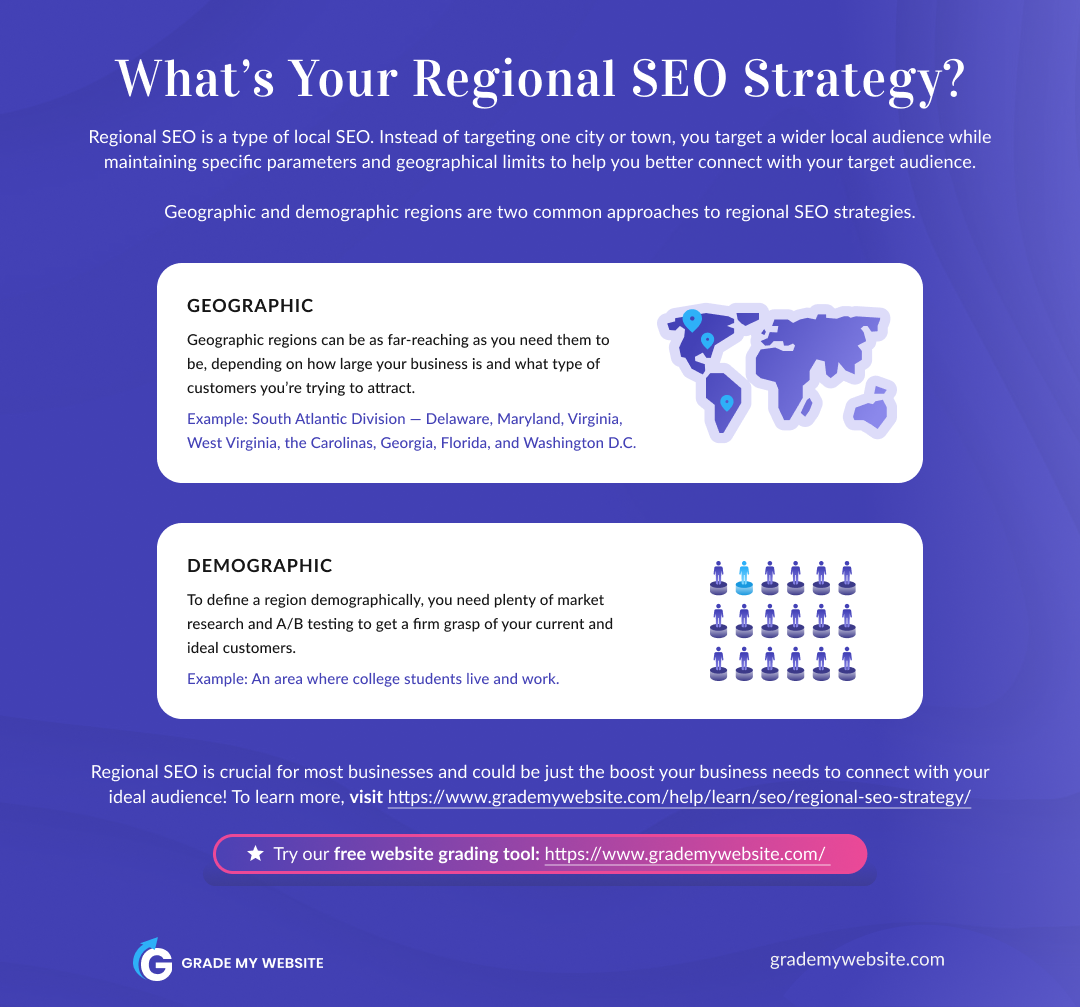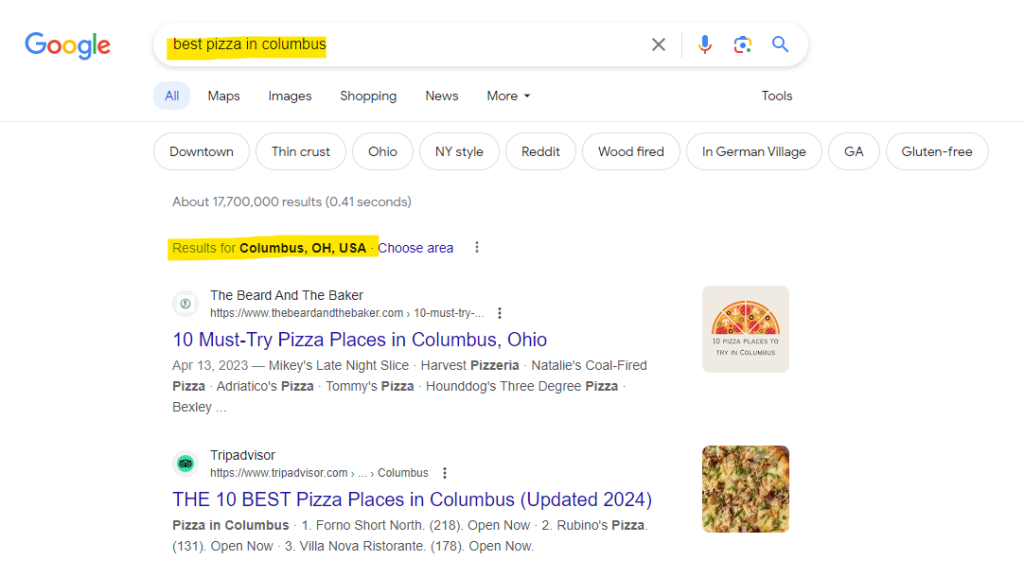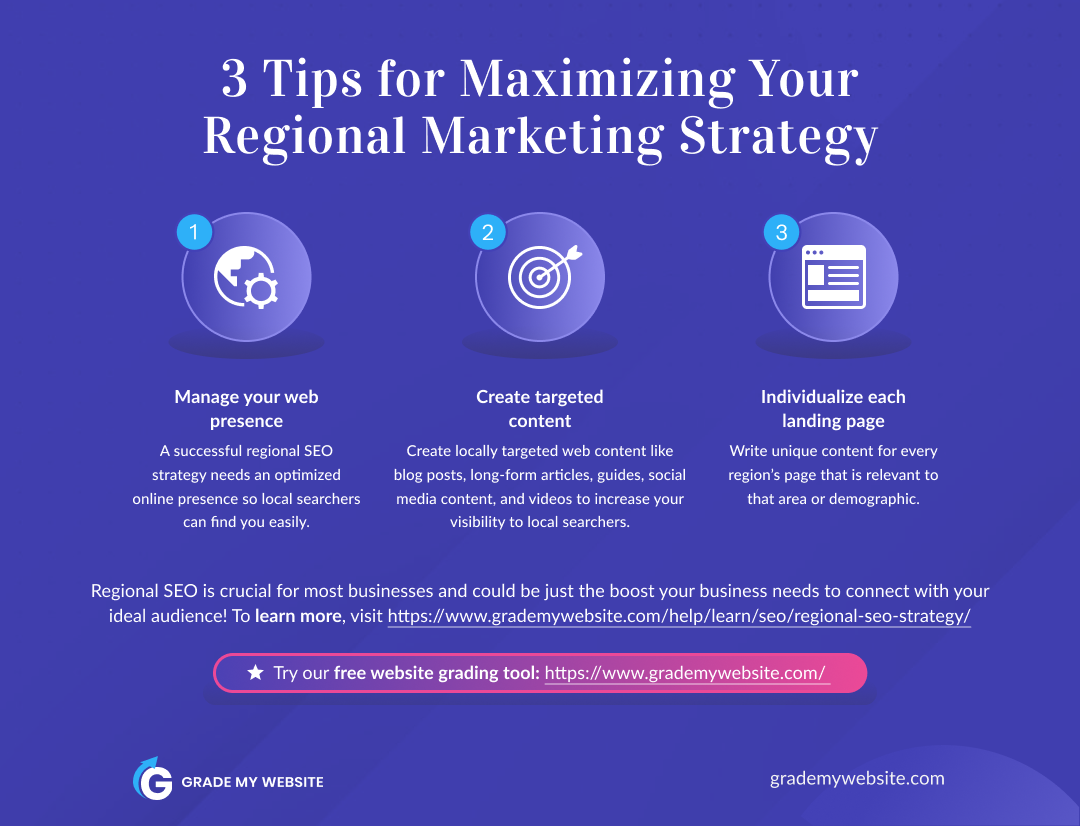What’s Your Regional SEO Strategy?
Regional SEO is the practice of optimizing a website so that it appears at the top of search results for products, services, or information related to a specific region. A regional SEO strategy goes beyond local SEO by targeting larger geographic areas instead of just individual cities or towns.
What is a regional SEO strategy?
A regional SEO strategy enables you to reach a broader local audience by setting specific parameters and geographical limits, ensuring stronger connections with your target audience in your desired locations.

Here’s an example:
When you’re searching for the name of the new store down the street or trying to find the best pizza spot near your vacation rental, what do you type into Google?
You probably search for something like “pizza shops near me” or “best pizza in Columbus.” “Near me” and “in [location]” are two popular phrases for local search and great examples of regional SEO in action.

Defining the “region” in your regional SEO strategy
Deciding to launch a local SEO marketing campaign is one thing, but how do you know which region to target?
Regions are less defined than searches that target a specific city or neighborhood. However, if you cast your net too broad, you might lose the value of a locally targeted campaign.
2 most common approaches to regional SEO strategies
Every business, marketer, and campaign has their own definition of a region, and you should base yours on your own history, analytics, goals, and customers. Geographic and demographic regions are two common approaches to regional SEO strategies.
1. Geographic
Geographic regions can be as far-reaching as you need them to be, depending on how large your business is and what type of customers you’re trying to attract. Sticking to the standard West, Midwest, South, and Northeast regions might be too broad, so dig deeper into each region to find your audience.
For example, if the South is too wide of a net, targeting the South Atlantic Division — Delaware, Maryland, Virginia, West Virginia, the Carolinas, Georgia, Florida, and Washington D.C. — might better fit your goals.
Businesses like delivery services, taxis, and contractors can get even more precise by targeting individual counties or zip codes. Ultimately, though, the geographic region you target will depend on your business and target audience.
2. Demographic
To define a region demographically, you need plenty of market research and A/B testing to get a firm grasp of your current and ideal customers. If your direct competitor targets a particular region by demographic, that’s a great place to start.
A local SEO strategy targeting specific demographics could consider defining a region as:
- An area where college students live and work
- Low-income family neighborhoods
- Local cities with the highest concentrations of unmarried singles
- Counties in a tri-state area with households earning over a certain income threshold
Does regional advertising make sense for your business?
Almost half of all Google searches are for local businesses, and 76% of local searches lead to customers visiting a business within a day.
Regional SEO is easily one of the most effective and low-cost ways to reach the right group of leads. Not to mention, there aren’t many industries or brands that wouldn’t benefit from some regional targeting.
Regional SEO is especially vital for businesses in location-specific industries like law firms, real estate agents, and medical offices. A regional SEO strategy can also be excellent for franchise owners and businesses that can’t rely on steady foot traffic.
Even businesses without physical locations can take advantage of regional advertising. For example, an ecommerce store specializing in camping equipment and outdoor gear could launch a multiregional SEO campaign to target areas with the most active populations or those near major hiking trails and campgrounds.
Don’t believe us about local SEO? Test out local searches in your area. If you find that a lot of your competitors are filling those top SERP spots, they’ve likely optimized themselves for local searchers. That means it’s time to step up your game.
3 tips for maximizing your regional SEO strategy

Here are a few tips for maximizing your regional SEO and marketing strategy to get you started:
1. Manage your web presence
A successful regional SEO strategy needs an optimized online presence so local searchers can find you easily. Consider these ideas for managing your local web presence:
- Fill out your Google My Business page and keep it updated with current information
- Create establishment accounts and respond to reviews on popular travel and review sites, like Yelp or Trip Advisor
- Use relevant local keywords and keyword phrases on your website and in content
- Confirm that your social profiles and business accounts have the correct address and contact information for your business
- Implement a backlinking strategy that targets local websites and directories
- Stay up to date on local publications and opportunities to advertise your business digitally
2. Create targeted content
Create locally targeted web content like blog posts, long-form articles, guides, social media content, and videos to increase your visibility to local searchers. This allows you to leverage locally relevant keywords and give searchers a reason to visit your website or page.
Examples of locally targeted web content include:
- A social media post celebrating a local team’s recent win
- A blog post highlighting local activities
- Creating a curated list of must-see attractions in your targeted region
- Posting a video interviewing local celebrities and residents
- Sharing pictures of your business sponsoring a local charity, event, or club
- Compiling a shopper’s guide for local businesses, including your own
Make sure all your regionally targeted content is accurate, especially if you don’t live or work there. Your content should use the right words to describe neighborhoods or popular establishments and refer to well-known people, spots, or organizations.
Bonus points if you include insider tips or references that let the locals know you’re one of them. Does everyone line up hours before opening to get the first slice of pumpkin pie at the local diner? Does the local street musician play cover songs by request on weekends? Is parking cheaper on the west side of town? Put yourself in the mind of your customers. The more you become your customer, the more relevant and enticing your content and business will be.
3. Individualize each landing page
One of the most crucial considerations in launching a regional SEO campaign is ensuring your landing page is unique to that region.
If a customer finds your business online, only to find every regional page says the same thing and makes the same promises, they may start doubting your authenticity. Google also penalizes websites that rely on duplicated content and boosts websites with fresh, relevant content.
Every region’s page — and all content for each region — should be 100% original and relevant to that area or demographic. You can do this by:
- Adding a service map to the page and highlighting the region
- Creating copy discussing your relationship with the local area
- Using pictures and videos of your business actively engaged in that region or with that demographic
- Referencing regional events or demographic-specific interests
- Making the “find us” or “directions” part of your website more detailed with local landmarks, popular streets and shortcuts
Launching a regional SEO strategy? We’ll take care of it
Regional SEO is crucial for most businesses and could be just the boost your business needs to connect with your ideal audience. But all that market research, web optimization, keyword research, and ongoing management takes time and expertise. That’s where WebFX can help.
WebFX is a full-service digital marketing agency that’s home to a team of SEO experts. We’ve got the tools and insights to help you define, target, reach, and convert your regional customers. Request your free proposal today to learn more!
Google Maps SEO: 10 Tips to Rank Higher on Google Maps
What is Google Maps SEO? Google Maps SEO (search engine optimization) is the process of making your business visible on Google Maps when users search for related keywords to your business. As an internet user, you have likely done a Google search to find a local store selling the product you’re looking for near you. […]
Read moreHow To Check Google Ranking?
Learning how to check Google ranking lets you know how much exposure your website receives for specific keywords. Checking your website’s Google ranking may help you identify areas of strengths and weaknesses you can improve on to rank higher on the SERPs and boost your return on investment (ROI). Read on for more information about […]
Read moreWhat Is Google EEAT and How To Optimize Your Site?
Over the years, digital marketers have determined the key elements that produce a high-ranking webpage. But little is known about the Google algorithm that puts webpages at the top of the SERP. However, Google has provided helpful guidelines to ensure quality pages match user intent. Explore what Google EEAT is and what you can do […]
Read moreHow To Add Google Analytics to WordPress?
Google Analytics is one of the most efficient web analytics tools offered by Google for businesses and individuals who want statistics on a specific website’s performance. Further to this, it provides you as the site owner with data on visitor insights such as how they access the site, the channels they use, top keywords used to […]
Read more
